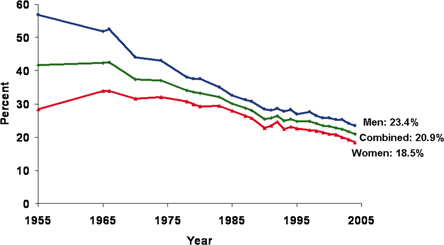Dr. Tyndale is a Scientist at the Centre for Addiction and Mental Health and a Professor of Pharmacology, University of Toronto. Mr. Siu, Mr. Al Koudsi, and Miss Ho are doctoral students in the Department of Pharmacology at the University of Toronto.
Recent decades have witnessed a revolution in public awareness about the dangers of smoking cigarettes, especially in the United States and most other developed nations. The number of smokers in those countries has plummeted. Largely because smoking is highly addictive, however, it remains a major, worldwide health threat.
According to the World Health Organization, smoking is currently responsible for the death of approximately 5 million people each year. If current trends continue, by the year 2030 an estimated that 10 million people will die each year because of smoking. In the United States alone, tobacco use today accounts for approximately $157 billion annually in health care costs and lost economic productivity.
Despite increasingly tough anti-smoking laws and policies, as well as heightened awareness of the negative health effects of cigarette smoking, approximately 21% of adults in the United States smoke. A key national health objective of the U.S. is to lower the number of adults who smoke to below 12% by the year 2010; and while there has been an overall decline in recent years, it does not appear that this goal will be met.
Smoking habits vary tremendously among American racial and ethnic groups, with American Indians/Alaska Natives having the highest rates at 33.4%, followed by non-Hispanic whites (22.2%) and non-Hispanic blacks (20.2%), and the lowest rates found among Hispanics (15.0%) and Asians (11.3%). The gender gap in smoking prevalence has dramatically narrowed in recent years, with overall current rates of 23.4% in men and 18.5% in women (Figure 1).The gender gap in smoking prevalence has dramatically narrowed in recent years, with overall current rates of 23.4% in men and 18.5% in women.
It is obvious that the development of better treatments for smoking addiction would have a massive health benefit. Research has given us greater understanding of the exact mechanisms of nicotine addiction within the human body, especially the role genes play.
Figure 1.
The Change in Smoking Prevalence in Men and Women From 1955 to 2005.*

Cokkinides, V. et al. Progress and opportunities in tobacco control. CA Cancer J Clin 2006;56(3):135-142.
Nicotine on the Brain
While as many as 80% of smokers say they want to quit smoking, only a small fraction -- less than 5% -- are actually able to get off cigarettes and stay off. This is mainly because inhaled nicotine, the main psychoactive ingredient in cigarettes, is powerfully addictive. Cigarettes, unlike other nicotine delivery systems (e.g., patch or gum), are particularly addictive because smoked nicotine is absorbed and reaches the brain quickly, within 10-20 seconds. Rapid delivery intensifies addictiveness by closely associating the behavior (smoking) and the reward (the pleasurable effect of nicotine on the brain).
Once it reaches the brain, nicotine causes mood elevation, decreased anxiety, decreased appetite, increased arousal and cognitive enhancement, by stimulating a part of the central nervous system called nicotinic acetylcholine receptors (nAChRs).
The main mechanism by which nicotine is thought to create addiction is by releasing a natural substance, dopamine, found in the brain. Dopamine has many functions in the brain. Most importantly, it is central to the reward/pleasure system, providing feelings of enjoyment as positive reinforcement to motivate us to perform certain activities.
Dopamine can be released by experiences such as eating, sex and the use of certain drugs.Nicotine also causes the release of other substances, called neurotransmitters, for example, serotonin and GABA. Serotonin helps regulate mood, sleep, sexuality and appetite and can indirectly cause dopamine release.
The Genetics of Nicotine Addiction
Cigarette smoking is a complex behavior that involves a number of stages such as initiation, experimentation, regular use, dependence, quitting and relapse. While factors such as the influence of family members, peers and culture undoubtedly affect smoking behavior, genetics also plays a role.
Twin studies have been used to determine whether complex traits such as smoking can be inherited and to what degree. This is known in genetics as "heritability," and it is expressed as a percentage. In other words, 0% heritability would mean that the risk for a particular behavior is the result of environmental influences; and 100% heritability would mean that the risk is essentially entirely from traits inherited from one's parents.
Based on numerous twin studies, the heritability for risk for trying smoking at all has been estimated in the range of 11-78%. Once smoking is initiated, the heritability for regular smoking has been estimated at 28-84%, for number of cigarettes smoked per day at 45-86% and for dependence on nicotine at 31-75%. A genetic influence on nicotine withdrawal symptoms and ability to quit has also been identified, with heritability estimated at 26-48% and 50-58%, respectively. Taken together, these studies suggest that genetics plays a large role in most aspects of smoking.Nicotine's addictive properties are a result of the activation of the special receptors (nAChRs) in the brain and the impact this has on certain neurotransmitter systems...
Advances in our understanding of the human genome have even allowed scientists to identify some of the specific genes involved in smoking. Nicotine's addictive properties are a result of the activation of the special receptors (nAChRs) in the brain and the impact this has on certain neurotransmitter systems (e.g., dopamine, serotonin and GABA). Genes that relate to the actions of these neurotransmitters, therefore, are the focus of researchers.
Dopaminergic System
The dopaminergic system, the part of the central nervous system that produces and regulates dopamine, has been studied extensively because of its pivotal role in nicotine dependence. Researchers have been able to pinpoint specific variations in specific genes that seem to affect smoking behavior. Some studies have even been able to suggest which anti-smoking therapies will be more effective for a particular individual.
Nicotinic Receptors
A recent study found an association between genetic variations in the brain nicotinic receptors with smoking quantity and heaviness of nicotine dependence.
Other Candidate Genes
The serotonin and the opioid systems, both parts of the central nervous system, also play a role in nicotine dependence. Not surprisingly, associations have been reported between genetic variants in serotonin or opioid receptors and various smoking behaviors and quitting rates.
The Promise of Genetic Association Studies
ADVERTISEMENT
Established Drug Treatments
Nicotine Replacement Therapies
Nicotine replacement products (NRTs) were one of the first treatments for nicotine dependence approved by the U.S. Federal Drug Administration (FDA). Today, there are several NRTs on the market, including gum, transdermal patch, vapor inhaler, nasal spray, lozenge and sublingual tablet. NRT treatments help people quit by delivering nicotine without the exposure to cancer-causing chemicals found in cigarette smoke. NRTs maintain the desirable emotional states (e.g., elevated mood, increased attention) achieved from smoking and avoid unpleasant withdrawal symptoms. Overall, NRTs have been fairly effective in helping smokers quit. No one type of NRT appears to be generally more effective than the others.
Bupropion (Zyban®)
Smoking and depression are linked in ways we do not yet fully understand. Certainly, both are influenced by dopamine levels in the brain.88,89 The first non-nicotine product to be used to help people quit smoking was the anti-depressant bupropion. Bupropion appears to work by reducing craving and by alleviating withdrawal symptoms; however, other less well understood mechanisms may also be involved.
Most -- but not all -- studies have demonstrated bupropion to be effective at helping smokers quit. As for safety, the drug causes few serious side effects, the most common being insomnia; nausea and vomiting; and dizziness.
Drugs Now in Development
Varenicline (ChantixTM)
Varenicline has recently been approved by the FDA to help people quit smoking. Varenicline seems to reduce nicotine reward during smoking and to stimulate dopamine release to reduce craving and withdrawal symptoms. Two separate studies found that varenicline more than doubled successful quitting rates after one year. Varenicline was also found to be significantly better at helping people stay off cigarettes than bupropion. The most common side effect of varenicline is nausea.
Nicotine Vaccines
Nicotine vaccines represent a new approach. The principle is to stimulate the body's production of antibodies which will prevent nicotine from entering the brain. One advantage of nicotine vaccines is that daily medication is not required. Two recent studies found that nicotine vaccines may be safe and effective. Further study will be needed, however, because of the small numbers of subjects in both studies. Most reported side effects were mild to moderate and were taken care of without medical treatment.
Rimonabant (SR141716)
Rimonabant prevents the release of dopamine in response to nicotine. Several studies have been done using this drug, with mixed results.The most common side effects were nausea and upper respiratory tract infection. Rimonabant has not yet been approved for use in the USA.
Metabolism Modulators
Another novel approach to helping people quit smoking would to administer drugs which prevent the body from metabolizing nicotine. They are currently under study.
Summary
Cigarettes are dangerous not because they contain nicotine but because of the variety of cancer-causing chemicals contained in cigarette smoke. Nicotine, however, is what makes cigarette smoking addictive. Like other abused drugs such as cocaine, nicotine acts on the central nervous system to stimulate feelings of pleasure and reward. Genetic studies have identified a host of genes that may contribute to an individual's risk of becoming addicted to tobacco, the strength of the addiction and the difficulty of quitting.
Current drug treatments for tobacco dependence include nicotine replacement therapies (NRTs), bupropion (Zyban®) and the newly approved varenicline (ChantixTM). Ongoing genetic studies, however, are likely to provide new classes of drugs and more effective treatments to help people quit smoking.
ADVERTISEMENT




